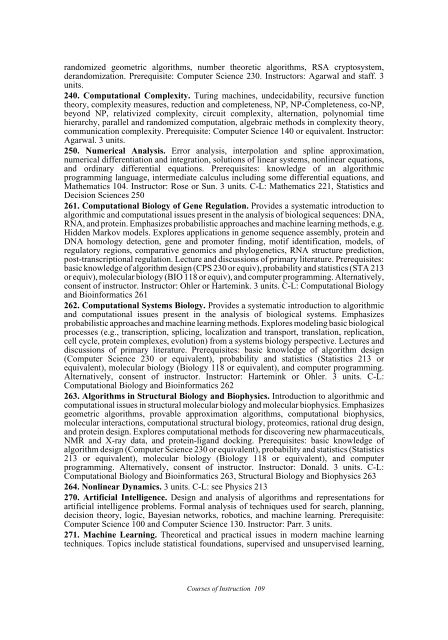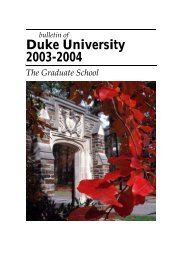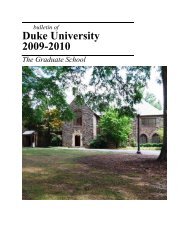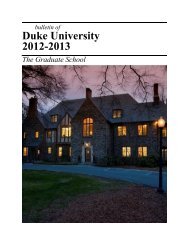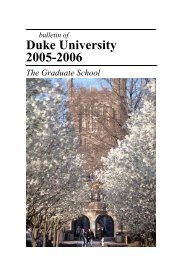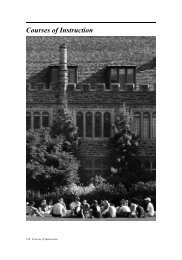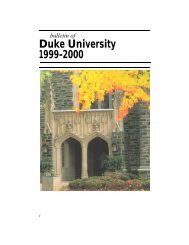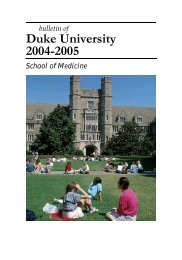Duke University 2008-2009 - Office of the Registrar - Duke University
Duke University 2008-2009 - Office of the Registrar - Duke University
Duke University 2008-2009 - Office of the Registrar - Duke University
Create successful ePaper yourself
Turn your PDF publications into a flip-book with our unique Google optimized e-Paper software.
andomized geometric algorithms, number <strong>the</strong>oretic algorithms, RSA cryptosystem,<br />
derandomization. Prerequisite: Computer Science 230. Instructors: Agarwal and staff. 3<br />
units.<br />
240. Computational Complexity. Turing machines, undecidability, recursive function<br />
<strong>the</strong>ory, complexity measures, reduction and completeness, NP, NP-Completeness, co-NP,<br />
beyond NP, relativized complexity, circuit complexity, alternation, polynomial time<br />
hierarchy, parallel and randomized computation, algebraic methods in complexity <strong>the</strong>ory,<br />
communication complexity. Prerequisite: Computer Science 140 or equivalent. Instructor:<br />
Agarwal. 3 units.<br />
250. Numerical Analysis. Error analysis, interpolation and spline approximation,<br />
numerical differentiation and integration, solutions <strong>of</strong> linear systems, nonlinear equations,<br />
and ordinary differential equations. Prerequisites: knowledge <strong>of</strong> an algorithmic<br />
programming language, intermediate calculus including some differential equations, and<br />
Ma<strong>the</strong>matics 104. Instructor: Rose or Sun. 3 units. C-L: Ma<strong>the</strong>matics 221, Statistics and<br />
Decision Sciences 250<br />
261. Computational Biology <strong>of</strong> Gene Regulation. Provides a systematic introduction to<br />
algorithmic and computational issues present in <strong>the</strong> analysis <strong>of</strong> biological sequences: DNA,<br />
RNA, and protein. Emphasizes probabilistic approaches and machine learning methods, e.g.<br />
Hidden Markov models. Explores applications in genome sequence assembly, protein and<br />
DNA homology detection, gene and promoter finding, motif identification, models, <strong>of</strong><br />
regulatory regions, comparative genomics and phylogenetics, RNA structure prediction,<br />
post-transcriptional regulation. Lecture and discussions <strong>of</strong> primary literature. Prerequisites:<br />
basic knowledge <strong>of</strong> algorithm design (CPS 230 or equiv), probability and statistics (STA 213<br />
or equiv), molecular biology (BIO 118 or equiv), and computer programming. Alternatively,<br />
consent <strong>of</strong> instructor. Instructor: Ohler or Hartemink. 3 units. C-L: Computational Biology<br />
and Bioinformatics 261<br />
262. Computational Systems Biology. Provides a systematic introduction to algorithmic<br />
and computational issues present in <strong>the</strong> analysis <strong>of</strong> biological systems. Emphasizes<br />
probabilistic approaches and machine learning methods. Explores modeling basic biological<br />
processes (e.g., transcription, splicing, localization and transport, translation, replication,<br />
cell cycle, protein complexes, evolution) from a systems biology perspective. Lectures and<br />
discussions <strong>of</strong> primary literature. Prerequisites: basic knowledge <strong>of</strong> algorithm design<br />
(Computer Science 230 or equivalent), probability and statistics (Statistics 213 or<br />
equivalent), molecular biology (Biology 118 or equivalent), and computer programming.<br />
Alternatively, consent <strong>of</strong> instructor. Instructor: Hartemink or Ohler. 3 units. C-L:<br />
Computational Biology and Bioinformatics 262<br />
263. Algorithms in Structural Biology and Biophysics. Introduction to algorithmic and<br />
computational issues in structural molecular biology and molecular biophysics. Emphasizes<br />
geometric algorithms, provable approximation algorithms, computational biophysics,<br />
molecular interactions, computational structural biology, proteomics, rational drug design,<br />
and protein design. Explores computational methods for discovering new pharmaceuticals,<br />
NMR and X-ray data, and protein-ligand docking. Prerequisites: basic knowledge <strong>of</strong><br />
algorithm design (Computer Science 230 or equivalent), probability and statistics (Statistics<br />
213 or equivalent), molecular biology (Biology 118 or equivalent), and computer<br />
programming. Alternatively, consent <strong>of</strong> instructor. Instructor: Donald. 3 units. C-L:<br />
Computational Biology and Bioinformatics 263, Structural Biology and Biophysics 263<br />
264. Nonlinear Dynamics. 3 units. C-L: see Physics 213<br />
270. Artificial Intelligence. Design and analysis <strong>of</strong> algorithms and representations for<br />
artificial intelligence problems. Formal analysis <strong>of</strong> techniques used for search, planning,<br />
decision <strong>the</strong>ory, logic, Bayesian networks, robotics, and machine learning. Prerequisite:<br />
Computer Science 100 and Computer Science 130. Instructor: Parr. 3 units.<br />
271. Machine Learning. Theoretical and practical issues in modern machine learning<br />
techniques. Topics include statistical foundations, supervised and unsupervised learning,<br />
Courses <strong>of</strong> Instruction 109


